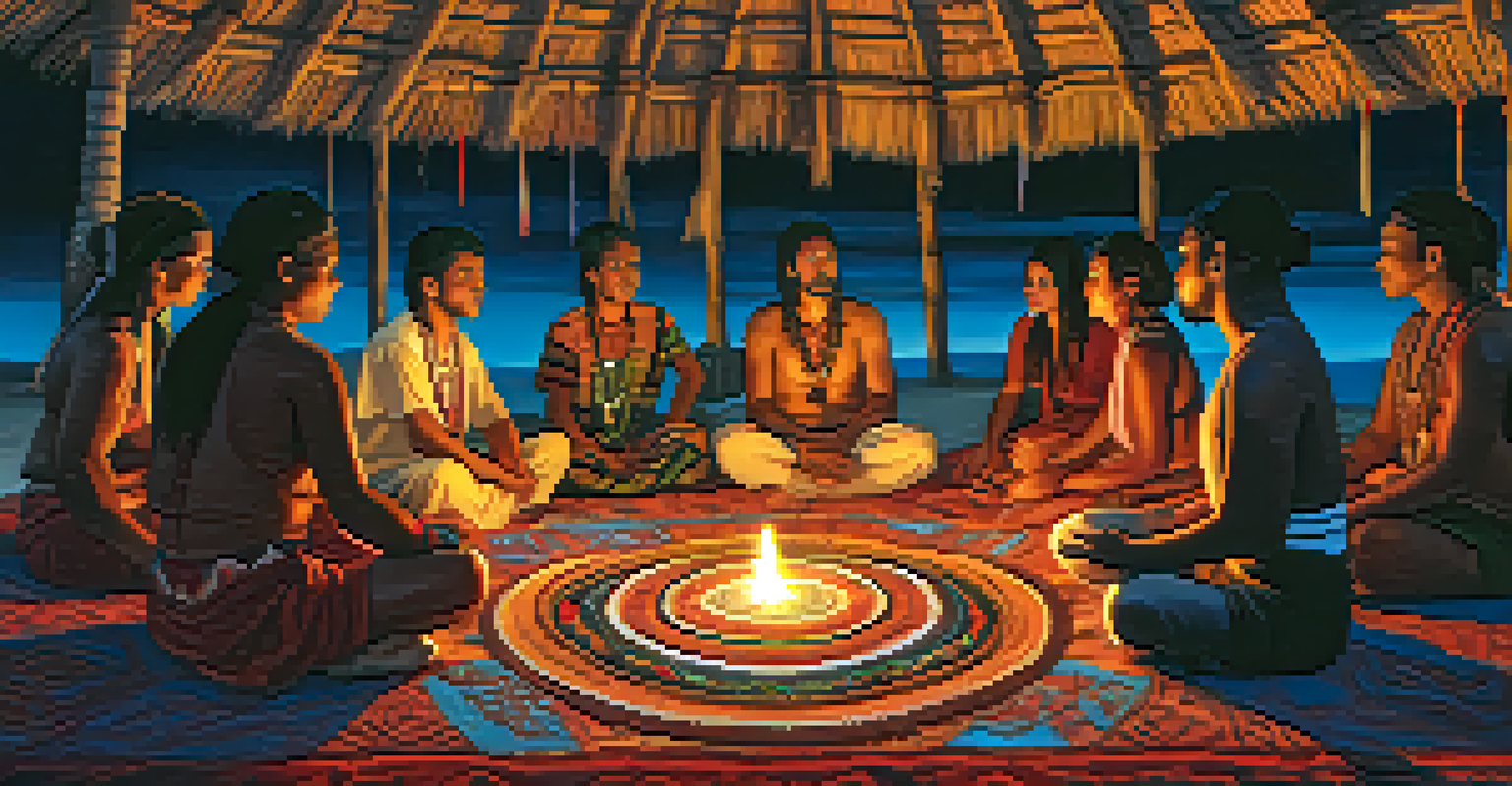The Healing Power of Ayahuasca Ceremonial Structure

Understanding Ayahuasca: Origins and Significance
Ayahuasca is a traditional plant-based brew originating from the Amazon rainforest, revered for its healing properties. It combines the Banisteriopsis caapi vine and the Psychotria viridis leaf, creating a powerful psychedelic experience. Indigenous cultures have used Ayahuasca for centuries in spiritual and healing practices, viewing it as a pathway to connect with the spirit world.
The experience of Ayahuasca can help one confront their fears and traumas, leading to profound healing and transformation.
The significance of Ayahuasca extends beyond its physical effects. It's often seen as a tool for personal transformation, helping individuals confront deep-seated fears and traumas. This brew facilitates a profound introspective journey, allowing participants to explore their thoughts and emotions in a safe and guided environment.
In recent years, Ayahuasca has garnered attention from the Western world, with many seeking its therapeutic potential. However, understanding its cultural roots is essential for appreciating its role in healing, respect for the traditions of the Amazonian tribes, and the wisdom they impart through these ceremonies.
The Structure of an Ayahuasca Ceremony
An Ayahuasca ceremony typically follows a structured format designed to create a sacred space for participants. This setting often includes a shaman or facilitator who guides the process, ensuring safety and support throughout the experience. The ceremony usually begins with an opening ritual, invoking spirits and setting intentions for the journey ahead.

Participants are encouraged to prepare themselves both physically and mentally before the ceremony. This preparation often involves dietary restrictions and meditation, which help to cleanse the body and focus the mind. As the ceremony unfolds, the shaman plays music, chants, and uses instruments to guide participants through their experiences, creating a harmonious and supportive atmosphere.
Ayahuasca's Cultural Roots Matter
Understanding Ayahuasca's significance requires respecting its indigenous origins and the spiritual practices of Amazonian tribes.
The structure of the ceremony is crucial for the healing process, as it fosters a sense of community among participants. Sharing experiences and insights with others can enhance understanding and provide emotional support, making the journey collectively transformative.
Setting Intentions: The First Step in Healing
Setting intentions is a vital part of the Ayahuasca experience, as it helps participants focus on what they hope to achieve during the ceremony. This practice encourages individuals to reflect on their desires for healing, whether it's emotional release, clarity, or spiritual growth. Intentions act as a guiding light, shaping the journey and providing context for the experiences that unfold.
Integration is the bridge between the insights gained during the ceremony and the everyday life that follows.
During the ceremony, participants can revisit their intentions, allowing them to stay grounded in their purpose. This process not only enhances the personal significance of the experience but also encourages deeper exploration of the issues at hand. The shaman may also remind participants of their intentions, helping to reinforce their focus.
By consciously setting intentions, individuals can cultivate a deeper understanding of their inner selves. This practice can lead to profound insights, often illuminating patterns or beliefs that no longer serve them, paving the way for healing and transformation.
The Role of the Shaman in Ayahuasca Ceremonies
The shaman plays a pivotal role in Ayahuasca ceremonies, acting as a spiritual guide and healer. Their knowledge of the plants and their properties, along with their connection to the spiritual realm, is crucial for a safe and meaningful experience. Shamans often undergo extensive training and initiation, which equips them with the skills necessary to facilitate healing.
Throughout the ceremony, the shaman uses various techniques to support participants, including chanting icaros, which are traditional songs believed to invoke healing energies. These songs can help create a protective atmosphere and guide participants through their journeys. The shaman's presence fosters a sense of safety, allowing individuals to explore their emotions and experiences without fear.
Intentions Guide the Healing Journey
Setting intentions during an Ayahuasca ceremony helps participants focus on their healing goals and enhances personal exploration.
Moreover, the shaman's ability to interpret and navigate the spiritual landscape can provide participants with insights that may not be immediately apparent. This guidance can help individuals process their experiences and integrate the lessons learned during the ceremony, enhancing the overall healing journey.
Navigating the Journey: Challenges and Insights
The Ayahuasca experience can be both beautiful and challenging, as participants may confront deep-seated fears or unresolved emotions. This process of facing inner demons can be daunting, but it's often necessary for healing. It's important to remember that discomfort can lead to growth, and many participants emerge from these experiences with newfound clarity and understanding.
During the ceremony, participants may experience intense emotions, visions, or even physical sensations. These experiences can vary widely from person to person, and it's crucial to approach them with an open mind. The shaman's guidance can help individuals navigate these challenges, reminding them that they are not alone on this journey.
Ultimately, the insights gained during these challenging moments can be transformative. They often provide participants with a clearer sense of purpose, a deeper understanding of themselves, and the ability to release old patterns that no longer serve them.
Post-Ceremony Integration: Applying Insights to Life
After an Ayahuasca ceremony, the process of integration becomes essential for translating insights into everyday life. Participants often find themselves reflecting on their experiences, contemplating the lessons learned, and considering how to apply these insights moving forward. This reflective practice helps solidify the healing that took place during the ceremony.
Integration can take many forms, such as journaling, discussing experiences with trusted friends, or engaging in therapy. These practices facilitate processing and understanding of the profound experiences encountered during the ceremony, helping individuals make sense of their journey. It’s crucial to give oneself time and space to absorb and integrate these insights.
Integration is Key Post-Ceremony
Post-ceremony integration is essential for translating insights gained during the experience into meaningful changes in daily life.
Support from the community can also play a significant role in the integration process. Sharing experiences with others who have undergone similar journeys can foster a sense of connection and understanding, making the transition back to everyday life smoother and more meaningful.
The Ongoing Journey: Embracing Healing and Growth
The healing power of Ayahuasca extends beyond the ceremony itself; it’s part of an ongoing journey of growth and self-discovery. Participants are often left with a renewed sense of purpose and a deeper connection to themselves and the world around them. This journey encourages individuals to embrace change and seek out further opportunities for healing.
Many who partake in Ayahuasca ceremonies find themselves drawn to continued exploration of spirituality, mindfulness practices, or even further ceremonies. These experiences can deepen their understanding of the self and provide ongoing support for their healing journeys. It's about cultivating a lifestyle that honors the insights gained.

Moreover, embracing the lessons learned from Ayahuasca can lead to positive changes in relationships, career paths, and overall life satisfaction. By integrating these insights into daily living, individuals can foster a more fulfilling and authentic existence, continuously evolving and growing along their path.